
Xylella fastidiosa in the EPPO region
- Special Alert -
As Xylella fastidiosa represents a very serious threat for the EPPO region, the EPPO Secretariat intends to provide on this page a brief description of the pathogen, as well as an easy access to specific EPPO data and other useful resources.
Xylella fastidiosa is a plant pathogenic bacterium
X. fastidiosa is a xylem-limited fastidious bacterium which causes several plant diseases of economic importance: grapevine Pierce's disease; citrus variegated chlorosis; peach phony disease; plum leaf scald, olive scorch; as well as leaf scorch diseases on almond, coffee, oleander, pecan, vaccinium, and amenity tree species.
From a taxonomic point of view, X. fastidiosa is a complex species and three subspecies have been formally accepted: subsp. fastidiosa, subsp. pauca and subsp. multiplex. However, since the formal publication of these subspecies, others have been proposed: subsp. sandyi (on Nerium oleander), subsp. tashke (on Chitalpa tashkentensis) and subsp. morus (on mulberry).
X. fastidiosa is thought to originate from the American continent. The outbreak in olive trees in Southern Italy, as well as the presence of the bacterium in Mediterranean plant species in the natural and urban landscapes of Southern Italy (Puglia), Corsica and Southern France, Islas Baleares and mainland Spain represent a significant change in its geographical distribution and constitute a major risk to many plant species in the EPPO region. In all infected areas in Italy, France and Spain, phytosanitary measures aiming at the eradication or containment of the disease are being taken.
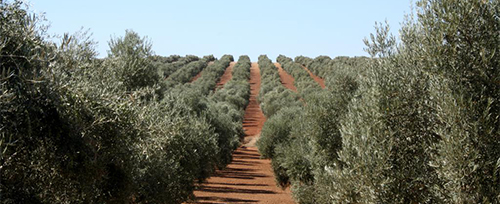
Healthy olive orchard in Spain – Matteo Maspero (IT)
EPPO Standards and information material on Xylella fastidiosa
- EPPO Standard: diagnostic protocol (NEW VERSION 2019)
- EPPO Standard: Inspection of consignments (2016)
- EPPO Standard: Inspection of places of production for Xylella fastidiosa (2016)
- Pictures of symptoms caused by Xylella fastidiosa
- Pictures of insect vectors in the USA:
- Xyphon fulgidum
- Draeculacephala minerva
- Graphocephala atropunctata - Geographical distribution (world map)
- EPPO Datasheet
- Articles in the EPPO Reporting Service
- EPPO Code for Xylella fastidiosa: XYLEFA
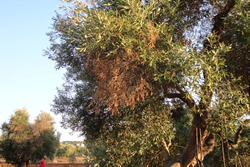
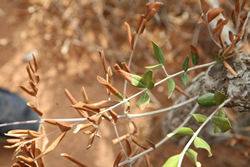
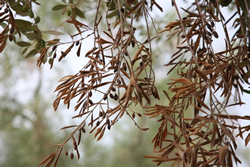
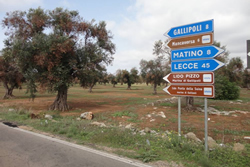
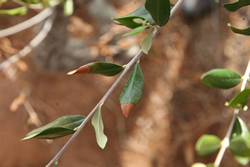
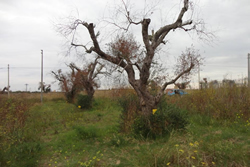
Symptoms of X. fastidiosa on olive trees in Puglia (Southern Italy). All pictures were kindly provided by Donato Boscia, Istituto di Virologia Vegetale del CNR, UOS, Bari (IT)
Franco Nigro, Dipartimento di Scienze del Suolo, della Pianta e degli Alimenti, Università degli Studi di Bari (IT) – Antonio Guario, Plant Protection Service, Regione Puglia (IT)
First reports of Xylella fastidiosa in the EPPO region
- Italy
In October 2013, X. fastidiosa was detected for the first time in olive trees affected by extensive leaf scorch and dieback in the area of Salento (Puglia, Southern Italy). Since then the disease has also been found in other provinces of Puglia (Lecce, Taranto, Brindisi and Bari), as well as in numerous other host plants (mainly ornamentals). In Puglia, the subspecies which has been detected is X. fastidiosa subsp. pauca.
Situation in Puglia : Emergenza Xylella | map
- France
In July 2015, the bacterium (X. fastidiosa subsp. multiplex) was discovered in France on the island of Corsica on Polygala myrtifolia planted as ornamentals in a commercial area of the municipality of Propriano. Many other outbreaks were then detected across the island of Corsica on various ornamentals and Mediterranean plants in urban and natural environments. The bacterium was then found in mainland France, first in the municipalities of Nice and Mandelieu-la-Napoule (Alpes-Maritimes), and then other foci were found in Provence-Alpes-Côte d'Azur region. In Southern France, X. fastidiosa subsp. multiplex has been detected in most cases, but X. fastidiosa subsp. pauca has been detected once in Menton.
Situation in Corsica: FREDON-Corse: Special Xylella fastidiosa - suivi des actions
Situation in Provence-Alpes-Côte d'Azur region: DRAAF - foyers de Xylella fastidiosa en région PACA
- Spain
In November 2016, X. fastidiosa subsp. fastidiosa was detected in Islas Baleares in 3 samples collected from sweet cherry (Prunus avium) in a garden centre on the island of Mallorca. Since then, several outbreaks were detected in other localities of Malloca, as well as in other islands of the archipelago (Ibiza, Formentera, and Menorca). Three different subspecies were detected in Islas Baleares: X. fastidiosa subsp. fastidiosa, X. fastidiosa subsp. multiplex and X. fastidiosa subspecies pauca in numerous plant species including wild and cultivated olive, almond, plum, cherry, grapevine, oleander and Mediterranean plants. In June 2017, X. fastidiosa subsp. multiplex was found in mainland Spain, in Alicante (Comunidad Valenciana) on almond trees.
Situation in Spain: Xylella fastidiosa
- Germany (isolated infestation now eradicated)
In July 2016, an isolated infestation of X. fastidiosa subsp. fastidiosa was detected in a potted plant of Nerium oleander, in a small glasshouse of a nursery producing young vegetables and ornamental plants in Saxony. In this glasshouse, all plants were destroyed in February 2017 and no further detections of the bacterium were made during intensive surveys conducted in the glasshouse and its surroundings. In March 2018, this isolated infestation was officially declared eradicated.
Host plants
X. fastidiosa is reported to infect more than 350 different host plants from more than 70 botanical families. Globally, the main economic hosts are grapevine (Vitis vinifera, V. labrusca, V. riparia), citrus (Citrus spp., Fortunella), almond (Prunus dulcis), olive (Olea europaea), peach (P. persica), coffee (Coffea spp.), and oleander (Nerium oleander). Interestingly, when the disease was first found in Southern Italy, there was at that time very little information in the scientific literature about olive trees being a host plant of X. fastidiosa. The bacterium has also been reported on other fruit crops: e.g. Asian pear (Pyrus pyrifolia), avocado (Persea americana), blueberries (Vaccinium corymbosum, Vaccinium virgatum), Japanese plum (Prunus salicina), pecan (Carya illinoinensis), plum (Prunus domestica), sour cherry (Prunus cerasifera), as well as on many amenity trees: e.g. American sycamore (Platanus occidentalis), American white elm (Ulmus americana), liquidambar (Liquidambar styraciflua), oaks (Quercus spp.), red maple (Acer rubrum), red mulberry (Morus rubra). X. fastidiosa has also been found in lucerne (Medicago sativa). Numerous wild plants and weeds can carry the bacterium without symptoms (e.g. wild grasses, sedges, lilies, various bushes and trees).
In the EPPO region, the main economic host is olive and the outbreak in Southern Italy has triggered a phytosanitary crisis. In Islas Baleares and Spain, the bacterium has been detected to a lesser extent in almond orchards but Prunus species are also economically important hosts. For the moment, detections of the bacterium in grapevine have been very isolated. Finally, X. fastidiosa has been detected in many ornamentals (e.g. Polygala myrtifolia) and Mediterranean species (e.g. Cistus, Lavandula, Myrtus, Nerium oleander, Rosmarinus, Spartium) growing in urban and natural environments.
Main symptoms
Symptoms vary according to the host plants but in general, as the bacterium invades xylem vessels and blocks the transport of water and soluble mineral nutrients, affected plants show drying, scorching, wilting of the foliage, eventually followed by plant death. Symptoms can be confused with those caused by other biotic or abiotic factors.
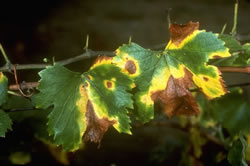
Pierce's disease of grapevine
Symptoms in cultivar Chardonnay
J. Clark - University of California, Berkeley (US)
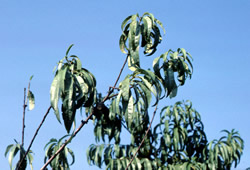
Peach phony disease
M. Scortichini, Istituto Sperimentale
per la Frutticoltura, Rome (IT)
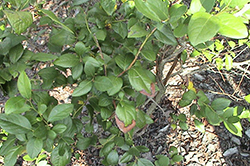
Leaf scorch on Vaccinium
Phillip M Brannen, University
of Georgia (US)
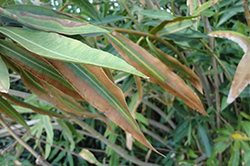
Leaf scorch on Nerium oleander.
Donato Boscia, CNR - Institute for Sustainable
Plant Protection, UOS, Bari (IT)
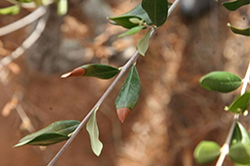
Leaf scorch on olive (Olea europaea)
Donato Boscia, CNR - Institute for Sustainable
Plant Protection, UOS, Bari (IT)
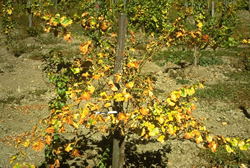
Pierce's disease of grapevine. Symptoms in cultivar
Chardonnay (under moisture stress)
A.H. Purcell - University of California, Berkeley (US)
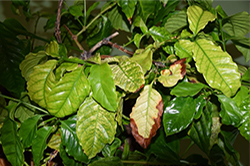
Symptoms on a coffee plant originating
from Ecuador (interception). Bruno Legendre.
Anses, Plant Health Laboratory, Angers (FR)
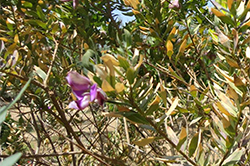
Symptoms on Polygala myrtifolia
Donato Boscia, CNR - Institute for Sustainable
Plant Protection, UOS, Bari (IT)
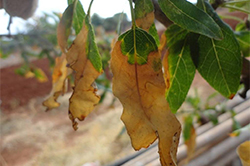
Leaf scorch on almond (Prunus dulcis)
Donato Boscia, CNR - Institute for Sustainable
Plant Protection, UOS, Bari (IT)
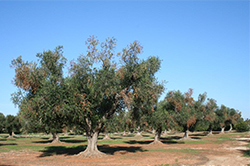
Affected olive (Olea europaea) orchard
Donato Boscia, CNR - Institute for Sustainable
Plant Protection, UOS, Bari (IT)
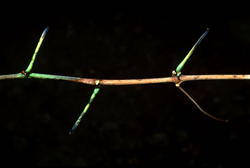
Pierce's disease of grapevine
Persistent petioles. J. Clark & A.H. Purcell,
University of California, Berkeley (US)
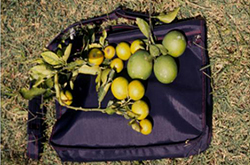
Citrus variegated chlorosis
(yellow diseased fruits on the left,
healthy green fruit on the right) – María M. López
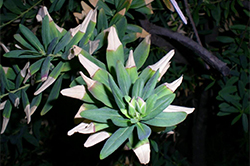
Symptoms on Polygala myrtifolia
Bruno Legendre, Anses
Plant Health Laboratory, Angers (FR)
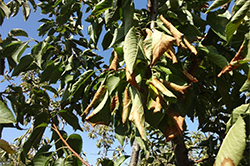
Symptoms on cherry (Prunus avium)
Donato Boscia, CNR - Institute for Sustainable
Plant Protection, UOS, Bari (IT)
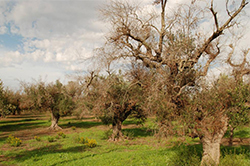
Severely affected olive (Olea europaea) orchard
Camille Picard
(DGAL-SDQPV, FR)
Insect vectors
In the field, X. fastidiosa is transmitted by insects belonging to the order Hemiptera, sub-order Auchenorrhyncha, which feed on xylem fluid. Bacteria colonize the insect foregut but do not systemically colonize the insect body. Transmission of X. fastidiosa by insects does not require an incubation period in the vector and the bacteria are persistently transmitted. Both nymphs and adults can acquire the bacteria by feeding on the xylem fluid of an infected plant and transmit the pathogen to healthy plants immediately after acquisition. Nymphs lose infectivity with every stage as the foregut is renewed with moulting. Newly emerged adults must feed on an infected plant to become infectious. X. fastidiosa is not transmitted transovarially to the progeny of the vector. However, once infected adults can transmit the pathogen during their entire lifetime.
In the Americas, numerous species of Cicadellidae and Cercopidae (Insecta: Hemiptera) are known to be vectors of X. fastidiosa. In Californian vineyards, Homalodisca vitripennis (=H. coagulata), Carneocephala fulgida, Draeculacephala minerva, and Graphocephala atropunctata are considered to be the most important vectors of Pierce's disease. In Brazilian citrus orchards, Acrogonia terminalis, Dilobopterus costalimai, Oncometopia fascialis are considered to be the most important vectors of citrus variegated chlorosis. In Italy, recent experiments have shown that Philaenus spumarius (Hemiptera: Aphrophoridae) can transmit the disease from olive tree to olive tree. in the EPPO region, the existence of other insect vectors is currently being studied and several potential vectors have been identified.
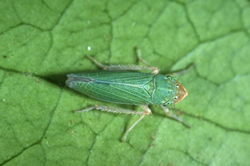
Xyphon fulgidum
J. Clark - University of California, Berkeley (US)
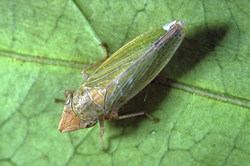
Draeculacephala minerva
J. Clark - University of California, Berkeley (US)
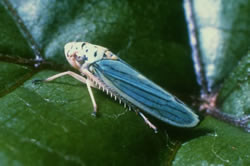
Graphocephala atropunctata
A.H. Purcell University of California, Berkeley (US)
Geographical distribution
The distribution below is given for Xylella fastidiosa on all host plants (maps for subspecies are under preparation). For many years, X. fastidiosa remained confined to the Americas. In 1994, it was first noticed in Asia, in Taiwan causing leaf scorch on Asian pear (Pyrus pyrifolia). In the 2000s, it was also reported causing Pierce's disease in some Taiwanese vineyards. In the EPPO region, the finding in Puglia (Southern Italy) represented the first confirmed detection in Europe. The introduction pathways of X. fastidiosa into Asia or Europe are unknown. However, it can be noted that EPPO member countries (e.g. France, the Netherlands, Switzerland) have intercepted several times X. fastidiosa on coffee plants imported for ornamental purposes from South America.
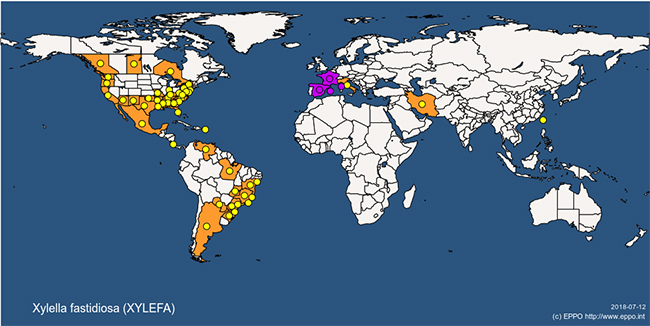
World distribution of X. fastidiosa (yellow: present – purple: transient) – map generated in 2018-07
Other useful sources
- EU Commission webpage on Xylella fastidiosa
- Pierce's disease .org
- Pierce's disease research symposium proceedings 2001 to 2017 (California Department of Food and Agriculture)
- Ponte project
- XF-actors project
